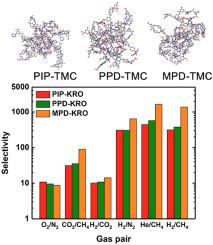当前位置:
X-MOL 学术
›
J. Membr. Sci.
›
论文详情
Our official English website, www.x-mol.net, welcomes your feedback! (Note: you will need to create a separate account there.)
Gas separation and water desalination performance of defect-free interfacially polymerized para-linked polyamide thin-film composite membranes
Journal of Membrane Science ( IF 9.5 ) Pub Date : 2021-01-01 , DOI: 10.1016/j.memsci.2020.118572 Zain Ali , Yingge Wang , Wojciech Ogieglo , Federico Pacheco , Hakkim Vovusha , Yu Han , Ingo Pinnau
Journal of Membrane Science ( IF 9.5 ) Pub Date : 2021-01-01 , DOI: 10.1016/j.memsci.2020.118572 Zain Ali , Yingge Wang , Wojciech Ogieglo , Federico Pacheco , Hakkim Vovusha , Yu Han , Ingo Pinnau

|
Abstract Introduction of interfacially polymerized (IP) polyamide thin-film composite (TFC) membranes in the 1980s revolutionized the reverse osmosis desalination industry. However, IP-derived TFCs have not achieved industrial success for gas separation applications due to the presence of membrane defects in their dry state. In this work, we report defect-free crosslinked polyamide thin-film composite membranes prepared from para-substituted aromatic and cycloaliphatic diamines, p-phenylenediamine (PPD) and piperazine (PIP), reacted with trimesoyl chloride (TMC). The key parameters in our modified IP process to mitigate defects are long reaction time (∼5 min) and high organic solution temperature (100 °C). The gas separation and desalination properties of the para-linked polyamide membranes were compared to previously reported polyamide TFCs made from meta-phenylenediamine (MPD) and TMC. The gas- and water permeances of the TFCs increased in the order: MPD-TMC PPD-TMC ≥ PIP-TMC. Elimination of defects allowed exploitation of the ultra-selective nature of polyamide TFCs, specifically for hydrogen and helium separations. At 23 °C, PIP-TMC, PPD-TMC and MPD-TMC exhibited H2/CH4 selectivities of 312, 362 and 1290, respectively, with moderate H2 permeances of 37.4, 32.6 and 25.8 GPU (1 GPU = 10−6 cm3(STP) cm−2 s−1 cmHg−1). Furthermore, the TFCs demonstrated excellent performance for H2/CO2 separation with pure-gas selectivities of 10-14 at 23 °C. The strong size-sieving capability of the polyamide TFCs originated from tight interchain packing induced by strong hydrogen bonding. Wide-angle X-ray diffraction confirmed a dominant fraction of submicropores of less than ∼4 A within PPD-TMC and PIP-TMC polyamide networks.
中文翻译:

无缺陷界面聚合对联聚酰胺薄膜复合膜的气体分离和水脱盐性能
摘要 1980 年代推出的界面聚合 (IP) 聚酰胺薄膜复合 (TFC) 膜彻底改变了反渗透海水淡化行业。然而,由于在干燥状态下存在膜缺陷,IP 衍生的 TFC 尚未在气体分离应用中取得工业成功。在这项工作中,我们报告了由对位取代的芳族和脂环族二胺、对苯二胺 (PPD) 和哌嗪 (PIP) 与均苯三甲酰氯 (TMC) 反应制备的无缺陷交联聚酰胺薄膜复合膜。我们改进的 IP 工艺中减少缺陷的关键参数是长反应时间(~5 分钟)和高有机溶液温度(100°C)。对位连接的聚酰胺膜的气体分离和脱盐性能与先前报道的由间苯二胺 (MPD) 和 TMC 制成的聚酰胺 TFC 进行了比较。TFCs的气体和水渗透性依次增加:MPD-TMC PPD-TMC≥PIP-TMC。消除缺陷允许利用聚酰胺 TFC 的超选择性特性,特别是用于氢气和氦气的分离。在 23 °C 时,PIP-TMC、PPD-TMC 和 MPD-TMC 的 H2/CH4 选择性分别为 312、362 和 1290,中等 H2 渗透率为 37.4、32.6 和 25.8 GPU(1 GPU = 10−6 cm3( STP) cm-2 s-1 cmHg-1)。此外,TFC 在 23 °C 下表现出优异的 H2/CO2 分离性能,纯气体选择性为 10-14。聚酰胺 TFC 的强大尺寸筛分能力源于强氢键诱导的紧密链间堆积。广角 X 射线衍射证实,在 PPD-TMC 和 PIP-TMC 聚酰胺网络中,小于~4 A 的亚微孔占主导地位。
更新日期:2021-01-01
中文翻译:

无缺陷界面聚合对联聚酰胺薄膜复合膜的气体分离和水脱盐性能
摘要 1980 年代推出的界面聚合 (IP) 聚酰胺薄膜复合 (TFC) 膜彻底改变了反渗透海水淡化行业。然而,由于在干燥状态下存在膜缺陷,IP 衍生的 TFC 尚未在气体分离应用中取得工业成功。在这项工作中,我们报告了由对位取代的芳族和脂环族二胺、对苯二胺 (PPD) 和哌嗪 (PIP) 与均苯三甲酰氯 (TMC) 反应制备的无缺陷交联聚酰胺薄膜复合膜。我们改进的 IP 工艺中减少缺陷的关键参数是长反应时间(~5 分钟)和高有机溶液温度(100°C)。对位连接的聚酰胺膜的气体分离和脱盐性能与先前报道的由间苯二胺 (MPD) 和 TMC 制成的聚酰胺 TFC 进行了比较。TFCs的气体和水渗透性依次增加:MPD-TMC PPD-TMC≥PIP-TMC。消除缺陷允许利用聚酰胺 TFC 的超选择性特性,特别是用于氢气和氦气的分离。在 23 °C 时,PIP-TMC、PPD-TMC 和 MPD-TMC 的 H2/CH4 选择性分别为 312、362 和 1290,中等 H2 渗透率为 37.4、32.6 和 25.8 GPU(1 GPU = 10−6 cm3( STP) cm-2 s-1 cmHg-1)。此外,TFC 在 23 °C 下表现出优异的 H2/CO2 分离性能,纯气体选择性为 10-14。聚酰胺 TFC 的强大尺寸筛分能力源于强氢键诱导的紧密链间堆积。广角 X 射线衍射证实,在 PPD-TMC 和 PIP-TMC 聚酰胺网络中,小于~4 A 的亚微孔占主导地位。



























 京公网安备 11010802027423号
京公网安备 11010802027423号